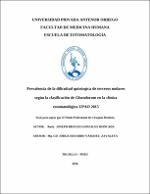| dc.contributor.advisor | Vasquez Zavaleta, Jorge Eduardo | |
| dc.contributor.author | Gonzales Moncada, Joseph Brayan | |
| dc.creator | Gonzales Moncada, Joseph Brayan | |
| dc.date.accessioned | 2016-10-04T21:22:16Z | |
| dc.date.available | 2016-10-04T21:22:16Z | |
| dc.date.issued | 2016 | |
| dc.identifier.uri | https://hdl.handle.net/20.500.12759/1905 | |
| dc.description.abstract | El presente estudio, tuvo como objetivo determinar la prevalencia del grado de dificultad
quirúrgica de terceros molares, según la clasificación de Gbotolorum, en la clínica
estomatológica UPAO 2015.
Según la naturaleza del estudio es de carácter retrospectivo, transversal, descriptivo y
observacional, desarrollándose en la clínica estomatológica UPAO; con un total de 108
radiografías panorámicas, basándonos en la clasificación de Gbotolorum, para establecer el
grado de dificultad de las terceras molares inferiores. Durante la evaluación de cada
radiografía panorámica, fue registrado el cuadrante, sexo, raza, edad, índice de masa
corporal, profundidad de punto de elevación y curvatura de raíces.
Los resultados nos muestran que el grado de dificultad quirúrgica más frecuente fue la
moderada 69.44%, seguida por la severa 24.07% y finalmente el nivel leve 6.48%.
Concluyendo, que el grado de dificultad quirúrgica más prevalente, según la clasificación de
Gbotolorum es la moderada; y que el sexo, la raza y el cuadrante no tienen influencia sobre
este grado de dificultad. | es_PE |
| dc.description.abstract | This study aimed to determine the prevalence of the degree of difficulty of third molar
surgery, as rated by Gbotolorum, UPAO dental clinic in 2015.
Depending on the nature of the study is retrospective, cross-sectional, descriptive and
observational, developed in the dental clinic UPAO; with a total of 108 panoramic
radiographs, based on the classification of Gbotolorum, to establish the degree of difficulty
of the lower third molars. During the evaluation of each panoramic radiograph it was
recorded quadrant, sex, race, age, body mass index, depth of lifting point and curvature of
roots.
The results show that the degree of difficulty was most frequent surgical moderate 69.44%,
followed by severe 24.07% and finally the slight 6.48% level.
Concluding that the most prevalent degree of surgical difficulty, as rated by Gbotolorum is
moderate; and that sex, race and quadrant have no influence on the degree of difficulty. | en_US |
| dc.description.uri | Tesis | es_PE |
| dc.format | application/pdf | es_PE |
| dc.language.iso | spa | es_PE |
| dc.publisher | Universidad Privada Antenor Orrego | es_PE |
| dc.rights | info:eu-repo/semantics/openAccess | es_PE |
| dc.rights.uri | https://creativecommons.org/licenses/by/4.0/ | es_PE |
| dc.source | Universidad Privada Antenor Orrego | es_PE |
| dc.source | Repositorio Institucional - UPAO | es_PE |
| dc.subject | Tercer molar | es_PE |
| dc.subject | Gbotolorum | es_PE |
| dc.title | Prevalencia de la dificultad quirúrgica de terceros molares según la clasificación de Gbotolorum en la Clínica Estomatológica UPAO 2015 | es_PE |
| dc.type | info:eu-repo/semantics/bachelorThesis | es_PE |
| thesis.degree.level | Título Profesional | es_PE |
| thesis.degree.grantor | Universidad Privada Antenor Orrego. Facultad de Medicina Humana | es_PE |
| thesis.degree.name | Cirujano Dentista | es_PE |
| thesis.degree.discipline | Estomatología | es_PE |
| dc.subject.ocde | https://purl.org/pe-repo/ocde/ford#3.02.14 | es_PE |
| renati.type | https://purl.org/pe-repo/renati/type#tesis | es_PE |
| renati.level | https://purl.org/pe-repo/renati/level#tituloProfesional | es_PE |
| renati.discipline | 911016 | es_PE |
| dc.publisher.country | PE | es_PE |


